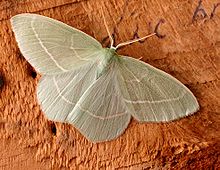Loading AI tools
Tribe of moths From Wikipedia, the free encyclopedia
Though small in absolute diversity of genera, the Hemitheini are nonetheless the largest tribes of geometer moths in the subfamily Geometrinae. Like most Geometrinae, they are small greenish "emerald moths". The tribe was first described by Charles Théophile Bruand d'Uzelle in 1846.
| Hemitheini | |
|---|---|
 | |
| Small emerald, Hemistola chrysoprasaria | |
| Scientific classification | |
| Domain: | Eukaryota |
| Kingdom: | Animalia |
| Phylum: | Arthropoda |
| Class: | Insecta |
| Order: | Lepidoptera |
| Family: | Geometridae |
| Subfamily: | Geometrinae |
| Tribe: | Hemitheini Bruand, 1846 |
| Genera | |
|
Several, see text | |
| Synonyms[1] | |
| |
In some treatments the Comostolini, Hemistolini, Jodini, Microloxiini, Thalassodini and Thalerini are split off as independent tribes. But they are probably paraphyletic among themselves and with respect to the remaining Hemitheini.[2] Consequently, until more information is available they are included in the Hemitheini here.
In other systems,[3] the Geometrinae are defined in a more inclusive way; the Hemitheini are then ranked as a subtribe Hemitheiti.
A few Geometrinae genera are not yet assigned to a tribe with certainty; some of them might belong here too.[4]
Seamless Wikipedia browsing. On steroids.
Every time you click a link to Wikipedia, Wiktionary or Wikiquote in your browser's search results, it will show the modern Wikiwand interface.
Wikiwand extension is a five stars, simple, with minimum permission required to keep your browsing private, safe and transparent.